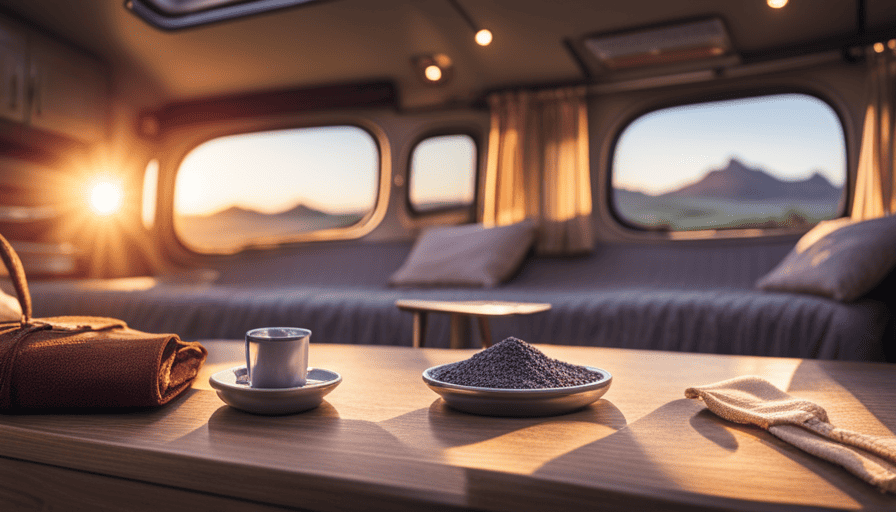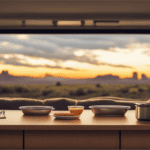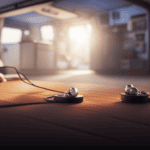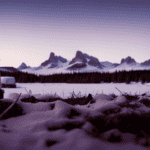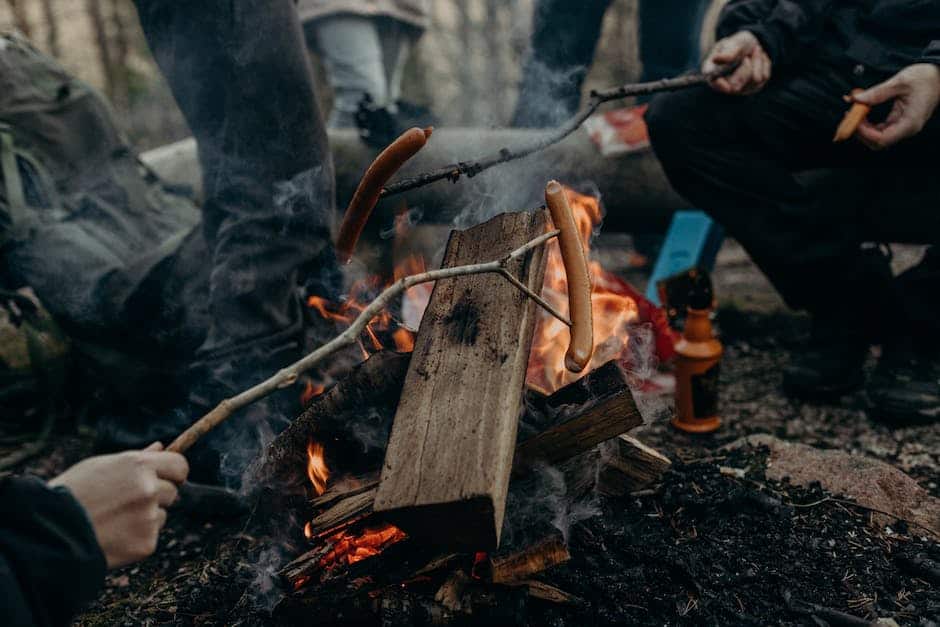Have you ever entered your beloved RV, only to be greeted by a persistent smell of mothballs? It feels like these small scented balls have taken up residence and refuse to leave.
But fear not, my fellow camper enthusiasts, for I have discovered a collection of tried-and-true methods to banish that mothball smell once and for all.
Imagine your camper as a hidden treasure, waiting to be unearthed and restored to its former glory. Just like an intrepid explorer armed with knowledge and determination, we too shall embark on a quest to conquer this olfactory challenge.
With a keen eye and a nose for freshness, we will identify the source of the smell, meticulously clean every nook and cranny, and employ natural odor absorbers to restore our camper’s pristine scent.
So, gather your cleaning supplies and prepare to embark on a transformative journey. Together, we shall rid your camper of that stubborn mothball smell, allowing you to fully enjoy your mobile sanctuary once more.
Let’s dive in and reclaim the sweet aroma of adventure!
Key Takeaways
- Identify the source of the mothball smell and thoroughly inspect the camper for visible mothballs or residue.
- Dispose of any found mothballs properly and clean the affected areas with vinegar and water.
- Store clothing and bedding in airtight containers or bags to prevent mothball odor.
- Use natural alternatives like cedar chips or lavender sachets to repel moths and eliminate the need for mothballs.
Identify the Source of the Smell
Now, you need to find out where that pesky mothball smell is coming from and banish it for good. Identifying the source of the smell is essential in order to effectively eliminate it.
There are several common causes of mothball odor in a camper, such as old mothballs left behind by previous owners, mothball residue on fabrics or surfaces, or even mothball containers that weren’t properly sealed.
To identify the source, start by thoroughly inspecting every nook and cranny of your camper, paying close attention to closets, cabinets, and hidden spaces. Look for any visible mothballs or residue. If you find any, dispose of them properly and clean the area with a mixture of vinegar and water to remove the smell.
Additionally, consider prevention tips such as storing clothing and bedding in airtight containers or bags, regularly airing out your camper, and using natural alternatives like cedar chips or lavender sachets to repel moths.
Once you have identified and eliminated the source of the mothball smell, it’s time to air out your camper and get rid of any remaining odors.
Air Out Your Camper
After giving your camper some time to breathe, you’ll notice that the musty aroma of mothballs begins to dissipate. To further accelerate the process and freshen up your camper, here are some air fresheners and ventilation tips to consider:
-
Open all windows and doors: Allow fresh air to circulate throughout the camper. This will help eliminate any lingering mothball smell and bring in a natural breeze.
-
Use natural odor absorbers: Place bowls of baking soda or activated charcoal in various areas of the camper. These absorbents will help neutralize and eliminate odors, including the mothball smell.
-
Try essential oils: Add a few drops of your favorite essential oil to cotton balls and place them strategically around the camper. The pleasant scent will help mask any remaining mothball odor.
-
Invest in a portable air purifier: Consider purchasing a portable air purifier with an activated carbon filter. These devices can effectively remove odors and freshen the air inside your camper.
By following these air fresheners and ventilation tips, you’ll be well on your way to eliminating the mothball smell. Next, we’ll discuss how to clean and vacuum your camper thoroughly to ensure a fresh and odor-free environment.
Clean and Vacuum Thoroughly
To create a truly refreshing and inviting atmosphere, it’s essential to give your camper a thorough cleaning and vacuuming. Not only will this help remove the mothball smell, but it will also eliminate any dirt and dust that may have accumulated over time. When it comes to vacuum maintenance, it’s important to regularly clean or replace the vacuum bag to ensure optimal performance. Additionally, check the vacuum’s filter and clean or replace it if necessary.
Now, let’s dive into some deep cleaning techniques that will help get rid of the mothball smell once and for all. Start by removing all the furniture and belongings from the camper to have a clear workspace. Use a mild detergent mixed with warm water to wipe down all surfaces, including walls, ceilings, and floors. Pay extra attention to areas that may have absorbed the odor, such as closets and cabinets. Don’t forget to vacuum the upholstery and carpets thoroughly, as these can also trap odors.
To keep things interesting, here’s a table showcasing some effective cleaning products and techniques:
| Product | Technique |
|---|---|
| White vinegar | Mix equal parts vinegar and water, then wipe surfaces |
| Baking soda | Sprinkle on carpets and upholstery, let sit for a few hours, then vacuum |
| Lemon juice | Mix with water and use as a natural cleaning solution |
By following these deep cleaning techniques, you’ll be well on your way to eliminating the mothball smell from your camper. Now, let’s transition into the next section about using natural odor absorbers.
Use Natural Odor Absorbers
Using natural odor absorbers can be a great way to freshen up the air in your camper, and did you know that certain plants, like lavender and eucalyptus, can naturally absorb odors and leave behind a pleasant scent?
Natural odor absorbers are a fantastic alternative to chemical-based products, as they’re not only effective but also safe for you and the environment. One popular natural odor absorber is baking soda. It works by neutralizing odors instead of simply masking them.
To use baking soda, sprinkle it liberally on carpets, upholstery, and any other areas that may have absorbed the mothball smell. Let it sit for a few hours or overnight, then vacuum it up. While baking soda is generally safe to use, it’s important to note that it can be abrasive, so avoid using it on delicate fabrics or materials.
Another advantage of using baking soda is that it’s affordable and readily available. However, it may not be as effective on strong or stubborn odors.
Now, let’s explore another option to tackle the mothball smell in your camper: trying odor eliminating products.
Try Odor Eliminating Products
If you’re looking for a quick and hassle-free solution, why not give odor eliminating products a try? There are a variety of products available on the market specifically designed to eliminate odors, including sprays and fragrance diffusers.
Odor eliminating sprays are a convenient option as they can be easily sprayed onto surfaces or fabrics to neutralize unpleasant smells. These sprays typically contain enzymes or chemicals that break down odor-causing molecules, effectively getting rid of the mothball smell in your camper.
Fragrance diffusers are another effective option for eliminating odors. They work by releasing a pleasant scent into the air, which can help mask and overpower the mothball smell. You can choose from a wide range of scents, such as lavender or citrus, to create a fresh and inviting atmosphere in your camper.
Using odor eliminating products can be a simple and effective way to tackle the mothball smell in your camper. However, if you prefer a more natural approach, you can also try using baking soda or coffee grounds, which are known for their odor-absorbing properties. These natural substances can help absorb and neutralize the mothball smell, leaving your camper smelling fresh and clean.
Use Baking Soda or Coffee Grounds
You can easily freshen up your camper by sprinkling baking soda or coffee grounds in strategic areas to absorb and eliminate any unwanted odors, leaving your space smelling clean as a whistle. Here’s how:
-
Baking soda benefits: Baking soda is a natural deodorizer that can effectively neutralize odors. Sprinkle it on the carpets, upholstery, and even inside storage compartments. Let it sit for a few hours or overnight before vacuuming it up. The baking soda will absorb the mothball smell, leaving behind a fresh scent.
-
Coffee grounds alternatives: If you don’t have baking soda on hand, coffee grounds can also do the trick. Place coffee grounds in a container with holes or a coffee filter, and then put it in different areas of your camper. The coffee grounds will absorb the unpleasant smell and leave a subtle coffee aroma behind.
-
Target problem areas: Pay extra attention to areas where the mothball smell is particularly strong, such as closets, cabinets, and any fabric-covered surfaces. Sprinkle baking soda or place coffee grounds in these areas to effectively combat the odor.
-
Repeat as needed: Depending on the severity of the mothball smell, you may need to repeat the process a few times. Be patient and consistent, and soon your camper will be free from the unwanted odor.
Now that the baking soda or coffee grounds have helped eliminate the mothball smell, let’s move on to the next step: utilizing vinegar or lemon juice to further freshen up your camper.
Utilize Vinegar or Lemon Juice
To further enhance the freshness of your camper, consider incorporating the natural power of vinegar or lemon juice. These natural remedies are effective in eliminating mothball smell and can provide alternative solutions for a more pleasant camping experience.
Vinegar is a versatile ingredient that has been used for centuries for various cleaning purposes. Its acidic properties make it an excellent odor neutralizer. To use vinegar, simply mix equal parts vinegar and water in a spray bottle. Spray the solution onto surfaces in your camper, such as upholstery, curtains, and carpets. Allow it to sit for a few minutes before wiping it away with a clean cloth. The vinegar will help eliminate the mothball smell and leave a fresh scent behind.
Lemon juice, on the other hand, is not only a natural odor eliminator but also a natural disinfectant. It contains citric acid, which can help break down and neutralize odors. To utilize lemon juice, squeeze fresh lemons and mix the juice with water in a spray bottle. Similar to vinegar, spray the solution onto surfaces in your camper and let it sit for a few minutes before wiping it away.
Incorporating these natural remedies into your cleaning routine can help eliminate mothball smell and provide alternative solutions for a more pleasant camping experience. Up next, we will explore the use of charcoal or activated carbon to further eliminate odors in your camper.
Use Charcoal or Activated Carbon
For a more refreshing camping experience, freshen the air in your camper by using charcoal or activated carbon. These alternatives to traditional air fresheners can be highly effective in eliminating mothball smells. Charcoal has been used for centuries as a natural odor absorber because of its porous structure. It traps and neutralizes odors, leaving your camper smelling fresh and clean. On the other hand, activated carbon goes a step further in the odor elimination process. It is specially treated to have a greater surface area, allowing it to absorb a wider range of odors and pollutants.
One of the key benefits of activated carbon is its ability to remove not only mothball smells, but also other unpleasant odors such as smoke, pet odors, and cooking smells. This makes it a versatile option for keeping your camper smelling fresh throughout your trip. Additionally, activated carbon is non-toxic and safe to use around pets and children.
To use charcoal or activated carbon in your camper, simply place them in open containers or pouches and distribute them around the interior. You can also place them near the source of the mothball smell for more concentrated odor absorption.
In the next section, we’ll explore another method to eliminate mothball smells in your camper: placing scented sachets or dryer sheets.
Place Scented Sachets or Dryer Sheets
Another effective way to combat unwanted odors is by strategically placing scented sachets or dryer sheets throughout your camper. These simple solutions can make a big difference in freshening up your space and getting rid of that stubborn mothball smell.
Here are five items that can help you in your quest for a fresh-smelling camper:
-
Scented sachets: These small bags filled with fragrant herbs or potpourri can be placed in drawers, cabinets, and closets to release a pleasant scent and mask any unwanted odors.
-
Dryer sheets: Not only are dryer sheets great for softening your clothes, but they can also be used to freshen up your camper. Simply tuck a few sheets in different areas of your camper, such as under cushions or in storage compartments, to eliminate odors and add a fresh scent.
By incorporating scented sachets or dryer sheets into your camper, you can enjoy a more pleasant and inviting environment. However, it’s important to remember that these solutions are temporary fixes. To truly keep your camper smelling fresh, it’s essential to keep it clean and well-ventilated. This will help prevent odors from building up and ensure a more enjoyable camping experience.
Keep Your Camper Clean and Well-Ventilated
Now that you’ve taken steps to add a pleasant scent to your camper with scented sachets or dryer sheets, it’s important to maintain a clean and well-ventilated environment to prevent musty odors and get rid of that lingering mothball smell.
Not only will a clean camper help eliminate odors, but it will also create a more enjoyable and healthy living space.
To keep your camper clean, start by creating a regular cleaning routine. Sweep or vacuum the floors, wipe down surfaces with a mild cleaning solution, and don’t forget to clean the curtains and upholstery regularly as well. Pay special attention to areas where mothballs may have been stored, such as closets or storage compartments.
In addition to regular cleaning, proper ventilation is key. Open windows and doors to allow fresh air to circulate throughout the camper. If weather permits, consider using fans or dehumidifiers to further improve air circulation and reduce moisture levels. Moisture can contribute to musty odors, so keeping humidity levels in check is essential.
By maintaining a clean camper and preventing musty odors, you’ll be able to enjoy your camping adventures without any unpleasant smells. Plus, a fresh-smelling camper will make your overall camping experience much more enjoyable.
Frequently Asked Questions
Can mothball smell in a camper cause any health issues?
Yes, exposure to mothball smell in a camper can potentially cause health issues. Mothballs contain harmful chemicals like naphthalene and paradichlorobenzene, which can irritate the eyes, nose, and throat. Prolonged exposure may lead to respiratory problems, headaches, and even liver or kidney damage.
To prevent health risks, it’s crucial to eliminate the mothball smell in the camper and ensure proper ventilation. Regularly airing out the space, using odor absorbers, and deep cleaning can help remove the lingering scent and minimize potential health hazards.
How long does it usually take to completely get rid of the mothball smell in a camper?
Typically, it takes some time to completely eliminate the mothball smell in a camper. However, there are ways to speed up the process.
First, ensure proper ventilation by opening windows and using fans to circulate fresh air.
Next, thoroughly clean all surfaces, including fabrics, with a mixture of vinegar and water.
Additionally, placing bowls of activated charcoal or coffee grounds can help absorb odors.
To prevent the smell from returning, store clothing and linens in airtight containers and regularly air out the camper.
Can I use mothballs to get rid of other odors in my camper?
Yes, there are alternative odor eliminators and natural remedies that can be used to get rid of other odors in your camper. Mothballs may work for some odors, but they have a strong and distinct smell of their own. Instead, I recommend trying options like baking soda, vinegar, activated charcoal, or essential oils. These natural remedies can help absorb and neutralize odors without leaving behind a strong scent.
Are there any specific cleaning products that work best for removing mothball smell?
The best cleaning products for removing mothball smell may vary depending on the specific situation, but there are a few options to consider.
One option is to use baking soda, which can absorb odors when sprinkled on surfaces and left overnight before vacuuming.
Another alternative is white vinegar, which can be mixed with water and used as a cleaning solution to help eliminate the odor.
Additionally, activated charcoal or odor eliminator sprays can also be effective in neutralizing mothball smell.
How often should I repeat the odor elimination process to maintain a fresh-smelling camper?
To maintain a fresh-smelling camper, I recommend repeating the odor elimination process every few months. This ensures that any lingering odors are kept at bay and your camper remains pleasant to be in. Effective odor elimination techniques, such as airing out the camper, using odor absorbers, and deep cleaning upholstery and surfaces, can help in maintaining freshness.
By consistently following these techniques, you can enjoy a pleasant and odor-free camping experience.
Conclusion
After following these steps, I was amazed at how effective they were in getting rid of the mothball smell in my camper. It took some time and effort, but the results were well worth it.
My camper now smells fresh and clean, and I can enjoy my camping trips without being overwhelmed by that unpleasant odor. Don’t let the mothball smell ruin your camping experience – try these methods and say goodbye to the stench for good.

